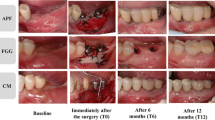Abstract
. There have been numerous surgical techniques developed for removing the epulis fissuratum lesions in order to improve alveolar ridge contour and improving adaptation of full prostheses. Most of these techniques can cause postoperative complications, such as oedema, pain, difficulty in swallowing and jaw movements, haemorrhage, infections and slow placement of final prostheses. The use of carbon dioxide (CO2) laser for the surgical removal of epulis lesions has resulted in many significant improvements including convenient mucosa removal, no bleeding or need for sutures, and minimal postoperative pain and oedema. This study is of 15 cases of removal of extensive epulis with vestibuloplasty in the maxilla and mandible that was carried out with CO2 laser, with no postoperative complications, rapid healing, and excellent aesthetic and functional outcome, all of which allowed for more rapid placement of final prosthesis.
Similar content being viewed by others
Author information
Authors and Affiliations
Additional information
Received for publication 15 June 1998; accepted following revision 18 December 1998.
Rights and permissions
About this article
Cite this article
Niccoli-Filho, W., Neves, A., Penna, L. et al. Removal of Epulis Fissuratum Associated to Vestibuloplasty with Carbon Dioxide Laser. Lasers Med Sci 14, 203–206 (1999). https://doi.org/10.1007/s101030050085
Issue Date:
DOI: https://doi.org/10.1007/s101030050085




